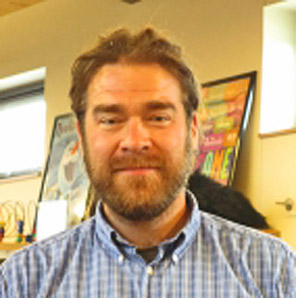 THE FINE ART OF NESTING
THE FINE ART OF NESTING Everyone has a story. Every voice has value. What better time than now to discover yours? We're offering workshops on paper making and kits for bookbinding. ... by Charlie Westerink
Read in Ned | January 18, 2018
by Michael Sivcovich
Last time I discussed STEM (science, technology, engineering, and mathematics) subjects and how we do our best to facilitate growth through activities for our elementary and middle/high school-aged friends. Well fear not, little ones, because now NCL has implemented STEM Storytimes for our preschool aged community members.
What does STEM look like for children under five, or even for those who can’t talk or grasp things yet? Foundations for STEM start with the non-numerical math concepts such as one-to-one correspondence and object permanence. Even tasks like sorting colored objects into appropriate groups helps establish STEM thinking systems, simply because it promotes critical thought and adjustment. When we look at STEM education, most is based on a cycle of planning, executing, and evaluation, although that is certainly an oversimplification of the majority of processes.
 When it comes to storytime, we tend to look more at tasks that are attainable for our kiddos and really try to ask questions that facilitate thinking about their thinking — this might be my favorite educational term: metacognition. When we ask children to think about their thinking, we are connecting some important little schema in their brains. For instance, Dan Siegel psychologist and educator, has written several books about a concept called the Whole Brain Child. In many of his books he talks about children’s brains having an “upstairs” (logical) and “downstairs” (emotional), and while the downstairs brain is ready to use almost at birth, the upstairs is still under construction — some research suggests, into your mid-20s.
When it comes to storytime, we tend to look more at tasks that are attainable for our kiddos and really try to ask questions that facilitate thinking about their thinking — this might be my favorite educational term: metacognition. When we ask children to think about their thinking, we are connecting some important little schema in their brains. For instance, Dan Siegel psychologist and educator, has written several books about a concept called the Whole Brain Child. In many of his books he talks about children’s brains having an “upstairs” (logical) and “downstairs” (emotional), and while the downstairs brain is ready to use almost at birth, the upstairs is still under construction — some research suggests, into your mid-20s.
Some of the hidden benefits of STEM thinking include developing the ability to connect these two sides of a developing mind. As the critical thinking aspect develops, it allows us to slowly and gently access it when working with our young children. When dealing with emotional children or even when appealing to their logic, it helps to acknowledge their emotional, ‘downstairs’ mind first before addressing to the logical “upstairs” mind. The more opportunities we give them to work with their upstairs mind, the better they become at bridging the two.
These systems of thinking allow children to reflect on their work in a productive manner, as the adults or teachers they are working with support these systems. That’s where the benefit of our STEM storytimes lies. It’s not just about inviting children to explore materials and ideas, but also to help us all understand what it means to tinker and experiment. I think most people who have worked as engineers, carpenters or really any profession have experienced a situation where what should work doesn’t and what shouldn’t work does. It is important that we allow children to explore their own theories and ideas about the world and find that when something doesn’t work, it isn’t necessarily that it’s wrong, but it may not be the solution to this particular situation.
We are continuing to improve upon and expand what topics we cover at our STEM storytimes here at NCL, and as we move through the sessions, there is tons to learn. Just like the system of thinking I mentioned above, it is important that we look critically at what is working and what is not working. It turns out that people tend to enjoy the things they improve with, since it gives us a sense of accomplishment and success. As we hone in our strategies for our STEM storytimes, more so will children’s strategies to navigate them.
Just a reminder, We are holding the Movers & Shakers STEM storytime on the second Wednesday of each month and the Read, Play, Grow STEM storytimes every other Thursday (call for updates as the latter may change from time to time). Happy tinkering everyone!
 Michael Sivcovich is the Youth Services Coordinator for the Nederland Community Library.
Michael Sivcovich is the Youth Services Coordinator for the Nederland Community Library.